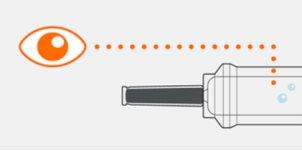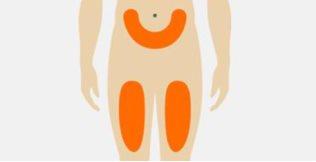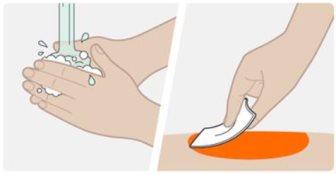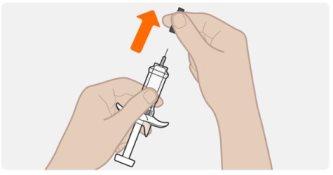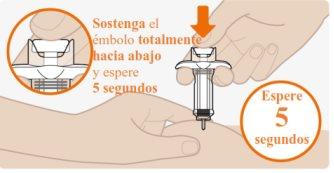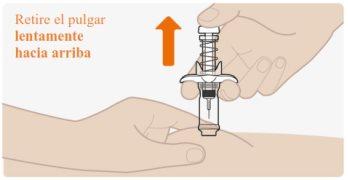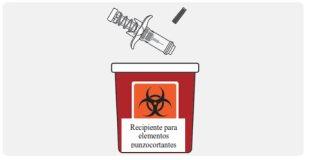
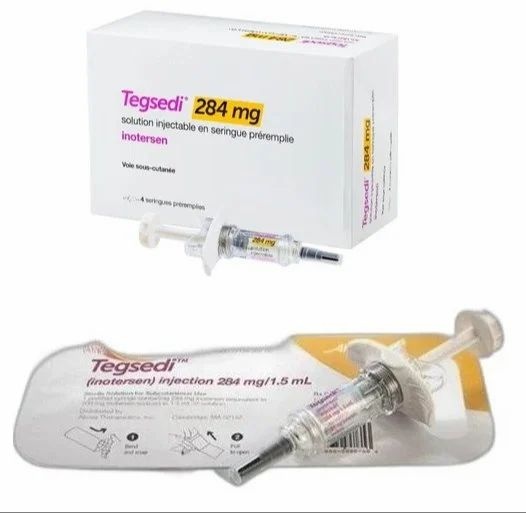
ТЕГСЕДІ 284 мг Розчин для ін'єкцій у попередньо заповненому шприці

Запитайте лікаря про рецепт на ТЕГСЕДІ 284 мг Розчин для ін'єкцій у попередньо заповненому шприці

Інструкція із застосування ТЕГСЕДІ 284 мг Розчин для ін'єкцій у попередньо заповненому шприці
Вступ
Опис: інформація для користувача
Тегседі 284 мг розчин для ін'єкцій у попередньо наповненому шприці
Інотерсен
Цей лікарський засіб підлягає додатковому моніторингу, що прискорить виявлення нової інформації про його безпеку. Ви можете допомогти, повідомляючи про будь-які побічні ефекти, яких ви можете зазнати. Остання частина розділу 4 містить інформацію про те, як повідомляти про ці побічні ефекти.
Прочитайте уважно весь опис перед тим, як почати використовувати цей лікарський засіб, оскільки він містить важливу інформацію для вас.
- Збережіть цей опис, оскільки вам може знадобитися знову його прочитати.
- Якщо у вас виникли питання, проконсультуйтеся з вашим лікарем, фармацевтом або медсестрою.
- Цей лікарський засіб призначений тільки вам, і не слід давати його іншим людям, навіть якщо вони мають相同ні симптоми, оскільки це може нашкодити їм.
- Якщо ви відчуваєте побічні ефекти, проконсультуйтеся з вашим лікарем, фармацевтом або медсестрою, навіть якщо це побічні ефекти, які не вказані в цьому описі. Див. розділ 4.
Зміст опису
- Що таке Тегседі і для чого він використовується
- Що вам потрібно знати перед тим, як почати використовувати Тегседі
- Як використовувати Тегседі
- Можливі побічні ефекти
- Зберігання Тегседі
- Зміст упаковки та додаткова інформація
1. Що таке Тегседі і для чого він використовується
Тегседі містить активну речовину інотерсен. Інотерсен використовується для лікування дорослих з сімейною амілоїдозою, викликаною транстиретином. Сімейна амілоїдоза, викликана транстиретином, - це генетичне захворювання, яке спричиняє накопичення малих волокон білка транстиретину в органах вашого тіла, що перешкоджає їх нормальній роботі. Тегседі використовується, коли захворювання викликає симптоми полінейропатії (ушкодження нервів).
Активна речовина в Тегседі, інотерсен, - це тип лікарського засобу, який називається інгібітором олігонуклеотиду антисенс. Він діє шляхом зменшення виробництва транстиретину печінкою, і тим самим зменшує ризик накопичення волокон транстиретину в органах і виникнення симптомів.
2. Що вам потрібно знати перед тим, як почати використовувати Тегседі
Не використовуйте Тегседі:
- якщо ви алергічні на інотерсен або на будь-який інший компонент цього лікарського засобу (перелічені в розділі 6).
- якщо аналізи показують, що у вас надто низький рівень тромбоцитів (клітин крові, які допомагають згортанню).
- якщо тести функції нирок або білка в сечі показують ознаки серйозних проблем з нирками.
- якщо у вас є серйозна недостатність функції печінки (печінкова недостатність).
Попередження та застереження
Перед тим, як почати лікування Тегседі, ваш лікар оцінить стан клітин крові, функцію печінки, функцію нирок, вітамін А та рівень білка в сечі. Також вони можуть провести тести, щоб переконатися, що у вас негативний результат тесту на вагітність. Якщо ваш лікар не рекомендував цього явно, вам буде призначено лікування Тегседі тільки якщо всі ці результати будуть на прийнятному рівні, а результат тесту на вагітність буде негативним. Ваш лікар повторюватиме ці тести регулярно під час лікування Тегседі. важливо, щоб ці аналізи крові та сечі проводилися регулярно, поки ви приймаєте Тегседі.
Тромбоцитопенія
Тегседі може зменшити кількість клітин крові, відповідальних за згортання (тромбоцитів), що може призвести до стану, відомого як тромбоцитопенія в будь-який момент під час лікування Тегседі (див. розділ 4). Коли тромбоцитів недостатньо, як це відбувається при тромбоцитопенії, ваша кров може не згортатися достатньо швидко, щоб зупинити кровотечі. Це може призвести до утворення синяків, а також інших більш серйозних проблем, таких як надмірне кровотеча або внутрішні кровотечі. Ваш лікар проведе аналізи крові для контролю рівня тромбоцитів перед лікуванням і регулярно під час всього лікування Тегседі. важливо, щоб ці аналізи крові проводилися регулярно, поки ви приймаєте Тегседі, через ризик серйозної кровотечі, викликаної низьким рівнем тромбоцитів. Якщо ви припините використовувати Тегседі, вам потрібно буде проводити контроль над станом крові через 8 тижнів після припинення лікарського засобу.
Якщо ви відчуваєте необумовлені синяки або появу малих червоних плям на шкірі (відомих як петехії), кровотечу з порізів на шкірі, яка не зупиняється, кровотечу з носа або десен, кров у сечі або калі, або кровотечу в білій частині очей, негайно проконсультуйтеся з вашим лікарем. Якщо у вас виникли симптоми, такі як жорсткість шиї або незвичайний і сильний головний біль, це може бути ознакою кровотечі в мозок.
Гломерулонефрит/проблеми з нирками
Гломерулонефрит - це стан нирок, при якому вони не працюють правильно через запалення і пошкодження нирок. Деякі пацієнти, які приймали інотерсен, мали цей стан. Симптоми гломерулонефриту включають піну в сечі, сечу рожевого або коричневого кольору, кров у сечі та зменшення кількості сечі.
Деякі пацієнти, які приймали інотерсен, також мали погіршення функції нирок без гломерулонефриту.
Ваш лікар буде контролювати функцію нирок перед лікуванням і регулярно під час лікування Тегседі. важливо, щоб ці аналізи крові проводилися регулярно, поки ви приймаєте Тегседі, через ризик серйозної кровотечі, викликаної низьким рівнем тромбоцитів. Якщо ви припините використовувати Тегседі, вам потрібно буде проводити контроль над функцією нирок через 8 тижнів після припинення лікарського засобу. Якщо у вас розвинеться гломерулонефрит, ваш лікар буде лікувати цю стан.
Дефіцит вітаміну А
Тегседі може зменшити рівень вітаміну А (також відомого як ретинол) в вашому організмі. Ваш лікар буде контролювати ці рівні, і якщо вони вже низькі, це потрібно буде виправити, і всі симптоми будуть усунені перед тим, як почати лікування Тегседі. Симптоми низького рівня вітаміну А включають:
- Сухі очі, погане зір, зменшення нічного зору, розmazаний або затуманений зір
Якщо у вас виникли проблеми з зором або будь-які інші проблеми з очима під час прийому Тегседі, повідомте про це вашому лікарю. Можливо, ваш лікар направить вас до спеціаліста з очей для консультації, якщо це необхідно.
Ваш лікар порекомендує вам приймати щоденний додаток вітаміну А під час лікування Тегседі.
Рівень вітаміну А, як надмірний, так і недостатній, може нашкодити розвитку плода. Тому жінки репродуктивного віку повинні виключити вагітність перед тим, як почати лікування Тегседі, і повинні використовувати ефективні методи контрацепції (див. розділ "Вагітність і лактація" нижче).
Якщо ви плануєте вагітність, ви припините приймати інотерсен, включаючи додатки вітаміну А, і переконаєтеся, що ваш рівень вітаміну А повернувся до норми перед тим, як планувати вагітність.
Якщо у вас виникла незапланована вагітність, ви припините приймати інотерсен. Однак через тривалу дію Тегседі ваш рівень вітаміну А може залишитися низьким. Невідомо, чи буде шкідливим для вашого плода продовжувати приймати додатки вітаміну А у вигляді 3000 МО на день під час першого триместру вагітності, але цю дозу не слід перевищувати. Ви відновите прийом додатків вітаміну А під час другого і третього триместрів вагітності, якщо ваш рівень вітаміну А ще не повернувся до норми, через підвищений ризик дефіциту вітаміну А у третьому триместрі.
Ушкодження печінки та контроль над печінкою
Тегседі може викликати серйозні проблеми з печінкою. Перед тим, як почати приймати інотерсен, вам потрібно буде пройти аналіз крові, щоб переконатися, що ваша печінка працює правильно. Також вам потрібно буде проходити ці аналізи крові регулярно, поки ви приймаєте цей лікарський засіб. важливо, щоб ці аналізи крові проводилися регулярно, поки ви приймаєте Тегседі.
Відторгнення трансплантату печінки
Проконсультуйтеся з вашим лікарем перед тим, як почати використовувати Тегседі, якщо ви мали трансплантацію печінки. Було повідомлено про випадки відторгнення трансплантату печінки у пацієнтів, які приймали Тегседі. Ваш лікар буде контролювати цей аспект регулярно під час лікування Тегседі.
Діти та підлітки
Тегседі не повинен бути використаний у дітей та підлітках молодше 18 років.
Інші лікарські засоби та Тегседі
Повідомте вашому лікарю або фармацевту, якщо ви приймаєте, нещодавно приймали або можете приймати будь-який інший лікарський засіб. важливо, щоб ви повідомили вашому лікарю, якщо ви вже приймаєте лікування будь-яким з наступних лікарських засобів:
- Лікарські засоби, які запобігають утворенню кров'яних згустків або зменшують кількість тромбоцитів у крові, наприклад, ацетилсаліцилова кислота, гепарин, варфарин, клопідогрел, ривароксабан і дабігатран.
- Будь-який лікарський засіб, який може змінити функцію нирок або пошкодити нирки, наприклад, сульфонаміди (використовуються як антибіотики), аніліди (використовуються для лікування лихоманки та болю), антагоністи альдостерону (використовуються як діуретики) та природні опіоїдні алкалоїди та інші опіоїди (використовуються для лікування болю).
Вагітність та лактація
Якщо ви вагітні або перебуваєте у період лактації, вважаєте, що можете бути вагітною або плануєте вагітність, проконсультуйтеся з вашим лікарем перед тим, як використовувати цей лікарський засіб.
Жінки репродуктивного віку
Тегседі зменшує рівень вітаміну А в вашому організмі, який важливий для нормального розвитку плода під час вагітності. Невідомо, чи може компенсувати ризик дефіциту вітаміну А, який може вплинути на вашого майбутнього дитини (див. "Попередження та застереження" у попередніх абзацах). Якщо ви жінка репродуктивного віку, ви повинні використовувати ефективні методи контрацепції, і потрібно виключити вагітність перед тим, як почати лікування Тегседі.
Вагітність
Не слід використовувати Тегседі, якщо ви вагітні, окрім випадків, коли ваш лікар явно рекомендував це.
Лактація
Інотерсен може потрапляти до грудного молока. Не можна виключити ризик для дитини. Проконсультуйтеся з вашим лікарем, чи потрібно вам припинити лактацію або припинити лікування Тегседі.
Водіння транспортних засобів та використання машин
Вживання Тегседі не показало впливу на здатність водити транспортні засоби або використовувати машини.
Тегседі містить натрій
Цей лікарський засіб містить менше 1 ммоль натрію (23 мг) на 1,5 мл, тому він практично "не містить натрію".
3. Як використовувати Тегседі
Слідувати точно інструкціям щодо застосування цього лікарського засобу, вказаним вашим лікарем. У разі сумнівів зверніться знову до вашого лікаря або фармацевта.
Рекомендована доза Тегседі - одна доза 284 мг інотерсену.
Дозу слід вводити один раз на тиждень. Всі наступні дози слід вводити один раз на тиждень, у той самий день тижня.
Шлях і форма введення
Тегседі призначений лише для підшкірного введення (шляхом субкутанної ін'єкції).
Інструкції з використання
Перед використанням попередньо заповненої шприцу ваш лікар покаже вам або вашому опікуну, як правильно його використовувати. Якщо у вас або вашого опікуна виникли сумніви, запитайте у вашого лікаря.
Прочитайте інструкції з використання перед початком використання попередньо заповненої шприци та кожного разу, коли вам повторно призначено лікарський засіб, оскільки можуть бути нові відомості.
Посібник з частин
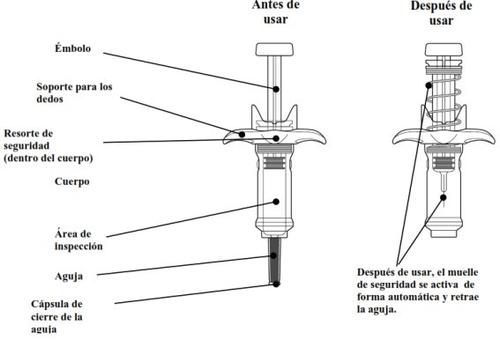
Кожна попередньо заповнена шприц містить одну дозу та призначена лише для одного використання.
ПОПЕРЕДЖЕННЯ | |
Незніміть захисний ковпачок з голки до тих пір, поки не дійдете до Пункту 6цих інструкцій та не будете готові ввінуті Тегседі. Неділіть шприц з іншою людиною та не повторно використовуйте шприц. Невикористовуйте попередньо заповнену шприц, якщо вона впала на тверду поверхню або пошкоджена. Незаморожуйте попередньо заповнену шприц. Якщо сталася одна з вище вказаних ситуацій, викиньте попередньо заповнену шприц у контейнер для колючих предметів та використайте нову попередньо заповнену шприц. | |
ПІДГОТОВКА | |
| |
Невводьте лікарський засіб, доки не зібрали перелічені вище матеріали. | |
| |
Не рухайте поршень. | |
| |
| Подивіться на область інспекції, щоб переконатися, що розчин прозорий та безколірний або світло-жовтого кольору. Нормально бачити бульбашки в розчині. Не потрібно нічого робити щодо цього. Невикористовуйте, якщо розчин виглядає мутним, забарвленим або містить частинки. Якщо розчин виглядає мутним, забарвленим або містить частинки, викиньте попередньо заповнену шприц у контейнер для колючих предметів (з гострим кінцем), та використайте нову попередньо заповнену шприц. |
| |
| Виберіть місце ін'єкції на животі (животі) або передній частині стегна. Місце ін'єкції також може бути зовнішньою областю верхньої частини руки, якщо Тегседі вводиться опікуном. Невводьте в область 3 см навколо пупка. Невводьте в одну й ту саму область кожен раз. Невводьте, якщо шкіра синяка, болюча, червона або тверда. Невводьте в тату, шрами або пошкоджену шкіру. Невводьте крізь одяг. |
| |
| Виїйте руки під водою та мийним засобом. Очистіть місце ін'єкції ватною підкладкою, змоченою спиртом, круговим рухом. Дайте шкірі висохнути на повітрі. Не торкайтеся області знову перед ін'єкцією. |
ВВЕДЕННЯ | |
| |
| Тримайте попередньо заповнену шприц за корпус, з голкою, що вказує назовні. Видаліть захисний ковпачок з голки, тягнучи його прямо. Не повертайте. Ви можете побачити краплю рідини на кінчику голки. Це нормально. Тримайте руки подалі від поршня, щоб уникнути натиснення на нього до того, як будете готові ввінуті Тегседі. Незніміть захисний ковпачок з голки до тих пір, поки не будете готові ввінуті Тегседі. Нетягніть захисний ковпачок з голки, тримаючи попередньо заповнену шприц за поршень. Звжди тримайте корпус шприци. Недозволяйте голці торкатися будь-якої поверхні. Невидаляйте будь-які бульбашки з попередньо заповненої шприци. Неповертайте захисний ковпачок на голку назад у попередньо заповнену шприц. |
| |
Тримайте попередньо заповнену шприц в одній руці. Тримайте шкіру навколо місця ін'єкції, як вам показав ваш лікар. Вам потрібно буде пом'якшити шкіру в місці ін'єкції, або ж вводити ін'єкцію без пом'якшення шкіри. Вставте голку повільно в обране місце ін'єкції під кутом 90° до тих пір, поки вона не буде повністю вставлена. Нетримайте попередньо заповнену шприц за поршень, ні не тисніть на поршень, щоб вставити голку. | |
| |
| Повільно та твердо натисніть на поршень повністю вниз, доки лікарський засіб не буде введений. Перевірте, чи голка повністю вставлена в місце ін'єкції, поки вводите лікарський засіб. Важливо натиснути на поршень повністю вниз. Попередньо заповнена шприц може зробити «клік» під час натиснення на поршень вниз. Це нормально. Неозначає, що ін'єкція закінчилася. Поршень може відчуватися жорстким наприкінці ін'єкції. Можливо, вам потрібно буде натиснути трохи сильніше на поршень, щоб переконатися, що ви натиснули його якомога далі. Невідпускайте поршень. |
| |
| Твердо натисніть на поршень наприкінці ін'єкції. Тримайте поршень повністю вниз та чекайте 5 секунд.Якщо ви відпустите поршень занадто швидко, ви можете втратити частину лікарського засобу. Поршень почне автоматично підніматися, що означає, що поршень був натиснутий повністю вниз. Повторно натисніть, якщо поршень не починає автоматично підніматися. |
| |
| Повільно відпустіть поршень та дайте пружині безпеки автоматично витягнути голку вгору. Тепер голка повинна бути безпечно відтягнута всередину попередньо заповненої шприци, а пружина механізму безпеки повинна бути видна на зовнішній частині поршня. Коли поршень зупиниться, ін'єкція завершена. Якщо поршень не піднімається автоматично після відпускання тиску, це означає, що не було активовано пружини безпеки, та вам потрібно буде повторно натиснути на поршень, але з більшою силою. Непіднімайте поршень вручну. Піднімайте всю попередньо заповнену шприц прямо вгору. Ненамагайтесь знову надіти захисний ковпачок на голку. Нетертіть місце ін'єкції. |
ВИДАЛЕННЯ ТА ПЕРЕДБАРАКА | |
Видалення використаної попередньо заповненої шприци | |
| Після використання негайно помістіть використану попередньо заповнену шприц у контейнер для колючих предметів. Не викидайте попередньо заповнену шприц у домашнє сміття. |
Якщо ви використали більше Тегседі, ніж потрібно
Зв'яжіться з вашим лікарем або фармацевтом, або негайно зверніться до відділення невідкладної допомоги лікарні, навіть якщо у вас немає жодних симптомів.
Якщо ви забули використати Тегседі
Якщо ви забули одну дозу Тегседі, введіть наступну дозу якомога скоріше, якщо тільки наступна запланована доза не буде протягом двох днів після цього, у цьому випадку слід пропустити забуту дозу та введіть наступну дозу згідно з графіком.
Неприймайте подвійну дозу, щоб компенсувати забуті дози.
Якщо ви перервали лікування Тегседі
Не перервуйте лікування Тегседі, якщо тільки ваш лікар не дорадить вам зробити це.
Якщо у вас є будь-які інші питання щодо використання цього лікарського засобу, запитайте у вашого лікаря, фармацевта або медсестри.
4. Можливі побічні ефекти
Як і всі лікарські засоби, цей лікарський засіб може викликати побічні ефекти, хоча не всі люди їх відчувають.
Важливі побічні ефекти
Якщо ви відчуваєте будь-який з наступних побічних ефектів, припиніть використання Тегседі та негайно зверніться до вашого лікаря:
- Симптоми, які можуть вказувати на гломерулонефрит (коли ваші нирки не працюють правильно), такі як піна в сечі, сеча рожевого або коричневого кольору, кров у сечі або сечовипускання менше звичайного. Гломерулонефрит є частим побічним ефектом інотерсену (може впливати до 1 людини з 10).
- Симптоми, які можуть вказувати на тромбоцитопенію (кров не згортається через низький рівень тромбоцитів у крові), такі як необґрунтовані синяки або висипання малих червоних плям на шкірі (називаються петехії), кровотеча з порізів на шкірі, яка не зупиняється, або гнояється, кровотеча з носа або десен, кров у сечі або фекаліях або кровотеча в білій частині очей. Низький рівень тромбоцитів у крові є дуже частим побічним ефектом інотерсену (може впливати до 1 людини з 10).
- Симптоми, які можуть вказувати на ушкодження печінки, такі як жовтяниця очей або шкіри, темна сеча, можливо, супроводжувана свербінням шкіри, біль у верхній правій частині області живота (абдомена), втратою апетиту, кровотечею або появою синяків легше звичайного, або відчуттям втоми.
Запитайте негайної допомоги, якщо ви відчуваєте жорсткість у шиї або незвичайний сильний головний біль, оскільки ці симптоми можуть бути викликані кровотечею в мозок.
Інші побічні ефекти
Дуже часті(можуть впливати більше 1 людини з 10)
- Зниження рівня червоних кров'яних тілець, яке може викликати блідість шкіри та спричинити слабкість або труднощі з диханням (анемія)
- Головний біль
- Вомітування або нудота (бажання вомітувати) - підвищення температури тіла
- Чувство холоду або ознобу
- Біль у місці ін'єкції, червоність, свербіння або синяки
- Набухання на щиколотках, ногах або пальцях рук (периферичний едем)
Часті(можуть впливати до 1 людини з 10)
- Збільшення кількості білих кров'яних тілець, званих еозинофілами (еозінофілія)
- Зниження апетиту
- Чувство головокружіння або ознобу, особливо при стоячі (низький кров'яний тиск, гіпотонія)
- Синяк
- Накопичення крові в тканинах, яке можна побачити як великий синяк (гематоми)
- Свербіння
- Висипання
- Ушкодження нирок, яке може викликати порушення ниркової функції або ниркову недостатність
- Зміни в результатах аналізів крові та сечі (це може вказувати на ушкодження печінки або нирок)
- Симптоми, подібні до симптомів грипу, таких як висока температура, болі та озноб
- Набухання або забарвлення шкіри в місці ін'єкції
Рідкі(можуть впливати до 1 людини з 100)
- Алергічна реакція
Звітність про побічні ефекти
Якщо ви відчуваєте будь-який побічний ефект, зверніться до вашого лікаря або фармацевта, навіть якщо це побічні ефекти, які не перелічені в цьому листку. Ви також можете повідомити про них безпосередньо через національну систему звітності, включену до Додатку V. Надсилаючи звіти про побічні ефекти, ви можете допомогти надати більше інформації про безпеку цього лікарського засобу.
5. Зберігання Тегседі
Тримайте цей лікарський засіб поза зором і досягненням дітей.
Не використовуйте цей лікарський засіб після закінчення терміну придатності, вказаного на коробці, подушці та попередньо заповненій шприці після CAD/EXP. Термін придатності - останній день місяця, який вказано.
Зберігайте у холодильнику (між 2°C та 8°C).
Не заморожуйте.
Тегседі можна зберігати без холодильника протягом 6 тижнів при температурі нижче 30°C. Якщо лікарський засіб не зберігався у холодильнику та не був використаний протягом 6 тижнів, його слід викинути.
Зберігайте у оригінальній упаковці, щоб захистити від світла.
Не використовуйте цей лікарський засіб, якщо ви помітили, що вміст є мутним або містить частинки.
Лікарські засоби не слід викидати у водопровідні труби чи сміття. Запитайте у вашого фармацевта, як позбутися упаковок та лікарських засобів, які вам більше не потрібні. Таким чином, ви допоможете захистити навколишнє середовище.
6. Зміст упаковки та додаткова інформація
Склад Тегседі
- Активний інгредієнт - інотерсен.
Кожен мл містить 189 мг інотерсену (у вигляді інотерсену натрію). Кожна попередньо заповнена шприц містить 284 мг інотерсену (у вигляді інотерсену натрію) у 1,5 мл розчину.
- Інші складові частини - вода для ін'єкційних препаратів, гідроксид натрію та хлоридна кислота (див. «Тегседі містить натрій» у розділі 2).
Вигляд продукту та вміст упаковки
Тегседі - ін'єкційний розчин, прозорий, безколірний або світло-жовтого кольору (pH 7,5 - 8,8) у попередньо заповненій шприці.
Тегседі випускається в упаковках по 1 або 4 попередньо заповнені шприци.
Можливо, що тільки деякі розміри упаковок будуть комерційно доступні.
Власник дозволу на розміщення лікарського засобу на ринку
Akcea Therapeutics Ireland Ltd
St. James House,
72 Adelaide Road, Dublin 2
D02 Y017, Ірландія
Відповідальний за виробництво
ABF Pharmaceutical Services GmbH
Brunnerstraße 63/18-191230 Відень
Австрія
Дата останнього перегляду цього листка: 11/2023
Детальна інформація про цей лікарський засіб доступна на сайті Європейського агентства з лікарських засобів: http://www.ema.europa.eu.
- Країна реєстрації
- Діючі речовини
- Потрібен рецептТак
- Виробник
- Інформація є довідковою і не є медичною порадою. Перед прийомом будь-яких препаратів обов'язково проконсультуйтеся з лікарем. Oladoctor не несе відповідальності за медичні рішення, прийняті на основі цього контенту.
- Альтернативи до ТЕГСЕДІ 284 мг Розчин для ін'єкцій у попередньо заповненому шприціФорма випуску: РОЗЧИН ДЛЯ ІН'ЄКЦІЙ, 25 мгДіючі речовини: vutrisiranВиробник: Alnylam Netherlands B.V.Потрібен рецептФорма випуску: ОРАЛЬНИЙ РОЗЧИН/СУСПЕНЗІЯ, 300 мг/млДіючі речовини: sodium oxybateВиробник: Accord Healthcare S.L.U.Потрібен рецептФорма випуску: ТАБЛЕТКА, ЩО ШВИДКО РОЗЧИНЯЄТЬСЯ В РОТІ / ЛІОТАБ, 50 мгДіючі речовини: riluzoleВиробник: Zambon S.P.A.Потрібен рецепт
Аналоги ТЕГСЕДІ 284 мг Розчин для ін'єкцій у попередньо заповненому шприці в інших країнах
Найкращі аналоги з тією самою діючою речовиною та терапевтичним ефектом.
Аналог ТЕГСЕДІ 284 мг Розчин для ін'єкцій у попередньо заповненому шприці у Україна
Лікарі онлайн щодо ТЕГСЕДІ 284 мг Розчин для ін'єкцій у попередньо заповненому шприці
Консультація щодо дозування, побічних ефектів, взаємодій, протипоказань та поновлення рецепта на ТЕГСЕДІ 284 мг Розчин для ін'єкцій у попередньо заповненому шприці – за рішенням лікаря та згідно з місцевими правилами.




